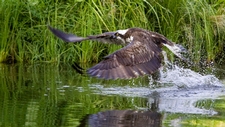Food Chains

TEKS Objective
The student is expected to identify and describe the flow of energy in a food chain and predict how changes in a food chain affect the ecosystem such as removal of frogs from a pond or bees from a field.
Essential Understanding
The student knows that organisms have characteristics that help them survive and can describe patterns, cycles, systems, and relationships within the environments.
Science Background
Energy, Ecosystems and the Atmosphere: BioEd Online (video) - Dr. Nancy Moreno introduces concepts related to ecosystems, energy flow through ecosystems and concepts related to producers and consumers.
Energy, Ecosystems and the Atmosphere
BioEd Online, www.bioedonline.org
Another Link in the Food Chain: Geography4Kids (website) - Quick review of the major components of food chains, along with an explanation of producers, consumers and decomposers, and their interactions.
Another Link in the Food Chain
Geography4Kids, http://www.geography4kids.com/
Energy Flow in Ecosystems: Wisconsin KEEP (website) – Overview of food chains and energy in ecosystems.
Energy Flow in Ecosystems
Wisconsin KEEP, http://www4.uwsp.edu/cnr/wcee/keep/
Signature Lesson
Food Chains: My Science Box (website) – Using a simple card sorting activity, students explore the concepts of food chains and the roles of producers, consumers and other organisms. Download separate documents including the food chain cards, lesson plan and a food pyramid overhead.
- Supporting Lessons
- Extensions
- Assessment Ideas
- Literature Connections
- Related
TEKS - Additional Resources
Supporting Lessons
Ecology, Habitats and Food Chains: Core Knowledge (PDF) - Multiple activities in which students explore ecology, habitats and food chains, and create their own habitats.
Ecology, Habitats and Food Chains
Core Knowledge, http://www.coreknowledge.org/
Elaboration Lessons and Extensions
Pond Water Web, Lesson Plan: Science Spot (PDF) - Students become familiar with common pond organisms, and then discover the role of these organisms in maintaining a balanced aquatic habitat by creating food webs. Includes student pages and assessment.
Pond Water Web, Lesson Plan
Science Spot, http://sciencespot.net/
The Antarctic Food Chain: National Geographic (website) - Students draw pictures, learn about the diet of various Antarctic animals, and create a classroom collage of a natural food chain in Antarctica, which illustrates the importance of krill to the Antarctic ecosystem.
The Antarctic Food Chain
National Geographic, http://www.nationalgeographic.com/expeditions/
Assessment Ideas
Identify the Food Chains: Penn State University (website) - Print this web page, provide a copy to each student, and have students answer the questions to assess their understanding of the flow of energy in a food chain.
Identify the Food Chains
Penn State University, http://www.cas.psu.edu/
Literature Connections
Food Chains. Rau Meachen, Dana (ISBN-13: 978-0761440956)
Who Eats What? Food Chains and Food Webs. Lauber, P. and Keller, H. (ISBN-13: 978-0064451307)
What are Food Chains and Webs? Kalman, Bobbie (ISBN-13: 978-0778776376)
An Antarctic Habitat. Alonian, Molly. (ISBN-13: 978-0778729846)
Arctic and Antarctic. Mack, Lorrie (ISBN-13: 978-0756619800)
Additional Resources
Chain Reaction: EcoKids (website): Online, interactive game that allows students to build a basic food chain, and learn about omnivores, predators and herbivores.
Chain Reaction
EcoKids, http://www.ecokids.ca/
Antarctica, The Play: The Open Door Website (website) - Play created by students to illustrate the natural circle of life in Antarctica and how living organisms depend on each other and the environment for survival.
Antarctica, The Play
The Open Door Website, http://www.saburchill.com/
TEKS Navigation
Grade 3
Need Assistance?
If you need help or have a question please use the links below to help resolve your problem.

Comments